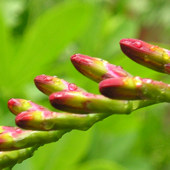2 July 2002
These mornings of rain
The area of the garden near the house - Kitchen
Corner - is mainly green, with leafy sculptural plants in pots, and
a stone sink full of water in which a white Arum lily (Zantedeschia
aethiopica "Crowborough") is flowering (and in which a frog
was spotted this week). The rain falling in this area seemed suddenly rather
beautiful, as drops bounced off large hosta leaves.
A shallow dish of water
on the ground made almost musical sounds as the raindrops fell into it.
Around the stone sink are pebbles, their wet surfaces suddenly reflecting
light. The darkness and heavy rain across the garden seemed comforting,
suddenly, as I realised I had to just watch it fall, and couldn't do any
actual work out there. I remembered Alice Walker's "These Mornings of
Rain" - one of those poems whose title is evocative as the poem itself.
I think I prefer rain to those merely cloudy, overcast days. At least rainy days, though dark, mean your plants are watered for you, and you don't have to feel guilty about not tending to your garden. I tried to keep up these positive thoughts, though more mundane ones interfered, as the torrential downpour reminded me that we really must put an end cap on the house guttering, so that it doesn't pour out all over the wall.
Clematis 'Jackmanii'
Also opening its first bloom is Clematis
'Jackmanii'. This plant - a well-established resident when we moved
here - has relocated its roots, which is rather clever of it. It was previously
growing in the "rain shadow" area near the south-facing wall, where the
soil is not only dried by the heat of the sun, but doesn't receive much
rainfall, because of the overhang of rather bushy ivy along the top of
the wall. Possibly because of this dryness at its roots, every year, when
it had been flowering for a while, it succumbed to a bad attack of powdery
mildew and looked distorted and sickly.
Being an old clematis, and originally trained to grow up a nearby tree
(since removed), it had a couple of long bare stems that grew low down,
horizontally, before climbing upwards. Probably as a result of the raising
of soil levels as I enriched the soil with manure and mulches, the stems
at some point made contact with the earth, and formed new roots at a
point further out from the wall.
This, of course, is something we encourage when we propagate a plant
by the process known as layering. I'm pleased though, having so many
gardening jobs to do already, when plants make the effort to layer themselves.
I noticed this had occurred last summer, and encouraged it, by feeding
and watering the area where the plant had decided to place itself. This
spring it was obvious that the "old" plant could be removed, and the
newly formed Clematis could take its place.
This isn't a Clematis 'Jackmanii' "Superba", the (apparently fairly old)
nursery label I discovered still wrapped around its lower stems gives
the variety as merely "Clematis 'Jackmanii'", and the description
as merely "Violet-purple".
Checking up my facts in Christopher Lloyd's excellent book on Clematis,
I read that this clematis is among the varieties he singles out as "special
martyrs" to powdery mildew.
Fighting the mildew with . . . milk
I don't want to use fungicide, as instinct - and in some cases evidence
- tells me someone or something else is usually inconvenienced - or even
harmed - for the sake of our "convenience". There's a nest full
of blackbird fledglings very
close by, and I expect they don't want Dithane 945 spray blowing across
them.
Last year I read that a spray made from diluted milk could help control
powdery mildew. I read this on the internet, and you can't believe everything
you read on the web (unless it's on this site, of course). But I can see
no reason not to spray the stuff over the Clematis 'Jackmanii', and I'm
sure the cats will be interested.
Clematis viticella "Etoile Voilette"
Another clematis of a very dark purple, Clematis viticella "Etoile Voilette",
has flowered beautifully this year, draping itself around an earlier-flowering
Clematis alpina whose display is now over.
The Christopher Lloyd book to which I'm referring for fact-checking
purposes helpfully contains a chapter on 'Names: their spelling and
pronunciation', and includes the following:
"Tom overheard someone tell a colleague that he had this clematis and it was doing well, whereupon the other person looked puzzled and asked what had a clematis to do with property leases? Was the name a joke? Following a lengthy conversation at cross-purposes (in a noisy public bar) the matter was resolved. The listener had been convinced the plant was called 'A Twelve Year Let'.
Christopher Lloyd - Clematis (Viking, 1989 edn,
revised with Tom Bennett) p204
Purple patch
The clematis mentioned above join a garden display that is already predominantly
purple. That there are so many things of a purple/violet/lilac hue is
probably the result of unconscious preference. Dark purple heliotrope
are flowering in pots, and I've also bought purple petunias as bedding
plants this year. The sweet
peas are flowering prolifically now: "Matucana" partly violet-coloured,
"Chatsworth" a pale lilac. At the far end of the garden Solanum
crispum "Glasnevin" has formed a vigorous loosely-branched
wall shrub, and continues to flower exuberantly, violet flowers with a
yellow eye. The delphiniums are purple or violet (the one that was labelled
"Sky Blue" looks like violet to me).
When the Crocosmia "Lucifer", the red nasturtiums and orange
heleniums flower the garden scene will be very different. For now,
on a moody, overcast day, the "purple haze" seems fitting. 'Scuse
me, while I kiss the sky.
Back to July highlights and diaries


